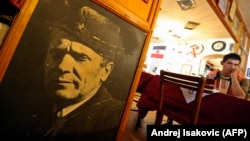Mario Milakovic has managed to keep something alive that politicians couldn’t.
The 35-year-old designer founded Yugodom, a stayover museum in Belgrade that allows visitors to see and feel a slice of what life was like in a country that is gaining popularity in its afterlife.
One hundred years after the country’s creation in 1918, Milakovic's venue is now one of the few places where Yugoslavia still exists.
“Yugodom could exist in an identical form as it does today, even if Yugoslavia never felt apart. What the circumstances of a post-Yugoslav context gave to Yugodom is that we can say that Yugodom is a place where you can visit a country that doesn't exist anymore," Milakovic says.
With the Austro-Hungarian and Ottoman empires in retreat at the end of the 19th century and start of the 20th century, the world turned its attention to the Balkans, which had had a rousing history, including the spark of World War I, the murder of Archduke Franz Ferdinand and his wife, on June 28, 1914, in Sarajevo.
Four years later, the Kingdom of Yugoslavia -- uniting an independent Serbia with Austro-Hungarian-ruled Croatia, and Slovenia under one flag -- was created on December 1, 1918, and existed until it was partitioned in 1941 during World War II.
On November 29, 1943, Yugoslavia, which literally means the land of the South Slavs, rose again, this time under the name Democratic Federal Yugoslavia.
Three years later the name was changed to the Federal Republic of Yugoslavia, and then to the Socialist Federal Republic of Yugoslavia in 1963, though its form remained the same until the early 1990s, when the country split apart at its ethnic seams.
Breakup And War
By April 1992, with its Soviet ally freshly dissolved, Yugoslavia as the world had known it was gone in a bloody and violent breakup, leaving some 100,000 dead, 2.4 million refugees, 2 million internally displaced, and seven independent nations in its place.
“As it was once said, Yugoslavia was easier to imagine than to achieve,” Latinka Perovic, a Serbian historian, quipped to RFE/RL.
Debate on why Yugoslavia failed is often heated, with fingers pointed in just about every direction.
Throughout its history, the country was saddled with the task of bringing together a diverse group of peoples, languages, religions, and cultures.
In its post-World War II incarnation, the country was held tightly together by the force of personality found in Josip Broz Tito.
Known for challenging Josef Stalin and creating a national communism that set Yugoslavia apart from the rest of the Warsaw Pact members, Tito came to power in 1953 and led the country until his death in 1980.
Born to Croatian and Slovene parents, Tito was careful to avoid the appearance that Serbia, twice as large as Yugoslavia’s second-biggest group, the Croats, did not dominate the decision-making process.
By spreading power among the different groups, and by snuffing out nationalism through his doctrine of “Brotherhood and Unity,” Tito’s Yugoslavia flourished in the 1960s and 1970s.
But his failing health in the late 1970s revealed the lack of a successor, and with it, says Raif Dizdarevic, the first Bosniak president to lead Yugoslavia’s collective presidency that Tito created in 1971, the lack of a clear path for the country to continue along.
“At one point, he [Tito] said: ‘You know what? If people after me say that everything was fine while I was alive, and that after me nothing is right, what did we do then?’” Dizdarevic, who spent more than three weeks with Tito just months before his death, recalls.
In the years after his death, the centralized control Tito exercised devolved along ethnic lines, culminating with the violent conflicts that saw first Slovenia, then Croatia, and subsequently Bosnia, Macedonia, and Montenegro, break away to become their own nations.
“I think all of the people in Yugoslavia lost when the country broke apart,” Dizdarevic adds.
Fondness For The Past
While those ethnic tensions still simmer in much of the former Yugoslavia, so too is a growing sentimental recollection of life in a country much of the younger generations can only learn about in history books and museums like Milakovic’s Yugodom.
A Gallup poll from last year showed that many people in the former Yugoslavia look back fondly at their former homeland.
In Serbia, around 81 percent of people think that the breakup of Yugoslavia harmed their country in its current context. Bosnians are not far behind, with 77 percent expressing regret over Yugoslavia’s dissolution.
Belgrade art historian Branislav Dimitrijevic’s book, titled Exhausted Socialism, argues against two dominant competing myths about ex-Yugoslavia: on the one hand, that it was a country of prosperity and security, and on the other, that it was a "prison of the peoples."
"I teach in an art school, and new generations are more and more interested in ex-Yugoslavia, as in their regular education they learn virtually nothing about that country. And not only do they learn very little about it, but the information they are receiving from their parents about that period is contradictory," Dimitrijevic told RFE/RL in Belgrade at the time of the poll.
Asked what Bosnians miss about Yugoslavia, Besim Spahic said that, above all, they miss the stability and harmony of interethnic relations.
"In Tito’s Yugoslavia, Bosnia was defined as a common state of Serbs, Croats, and Muslims. The focus was on shared values between different ethnic groups. Now the differences are highlighted and blown out of proportion."
"Bosnia was the most-Yugoslav of all the republics, with the largest number of multiethnic marriages," Spahic added. Twenty-five years later, only around 4 percent of all marriages in Bosnia are multiethnic.
The gloomy present faced by many arguably makes them more likely than some of their neighbors to indulge a rosy vision of the past -- at least some of which is fantasy.
Celebrated Legacy
This stereotype is seemingly perpetuated through popular culture and media that harken back to a better time.
“Yugoslavia has died, and I think it is an irreversible death,” says Budimir Loncar, who served as Yugoslavia's foreign minister from 1987 until 1991.
“But when anything disappears, it leaves a legacy behind.”
That legacy is now captivating visitors and locals alike in the Balkans.
In Podgorica, the capital of Montenegro, the city council decided in October to revisit its past. Known as Titograd for 47 years when it was part of Yugoslavia, the city voted to erect a monument to Tito to commemorate “a prominent figure, a revolutionary, a fighter against fascism, and one of the greatest world statesmen of the 20th century.”
Meanwhile, those wishing for an iconic slice of Yugoslavia can also choose to take a “Rise And Fall Of A Nation” tour of some of the former country’s most significant sites in a YUGO, the once hugely popular boxy automobile that is now more often the butt of jokes over its appearance and lack of reliability.
“In the average Yugoslav family, the YUGO counted as a true family member. At weddings, the Yugoslav flag was flaunted from its windows. It was rushed to the maternity ward for the safe birth of many newborn Yugoslavs. Yugoslav boys and girls in their teenage days “borrowed” the YUGO for a first ride around the block,” Yugotour says in a sales pitch on its website.
“As a stubborn car with components from all over Yugoslavia, the YUGO in many ways represents Yugoslavia.”













